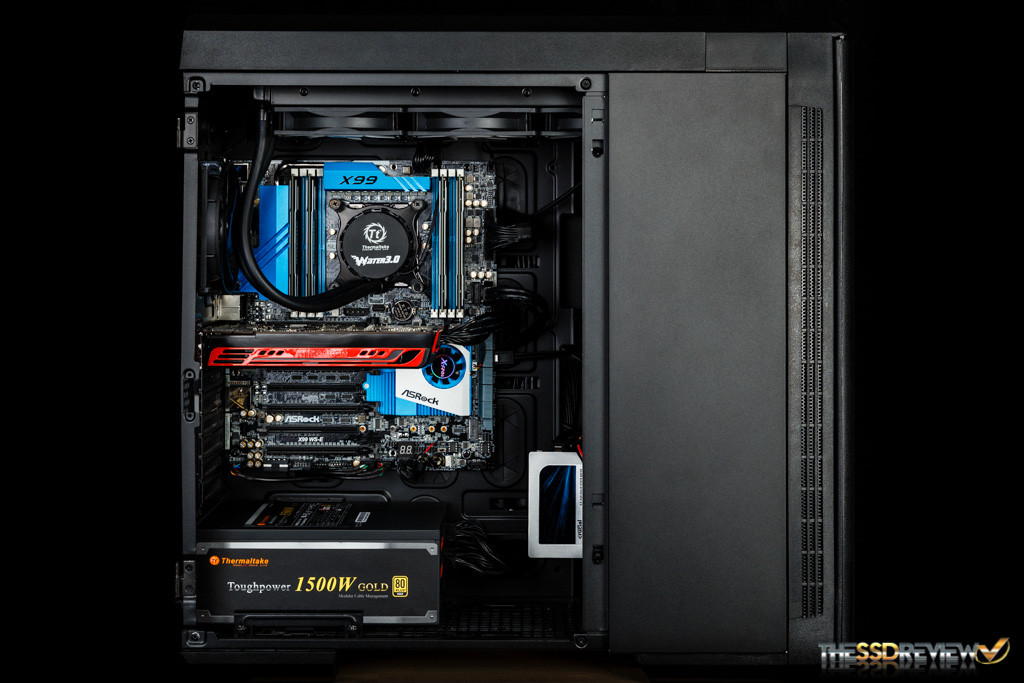TEST SETUP AND METHODOLOGY
In testing all enterprise drives we focus on long term stability. In doing so, we stress products not only to their maximum rates, but also with workloads suited to enterprise environments.
We use many off-the-shelf tests to determine performance, but we also have specialized tests to explore specific behaviors we encounter. With enterprise drives, you will see that we do not focus on many consumer level use-cases. Before each test the drive is purged and then preconditioned into a steady state before capturing its performance results. Our hope is that we present tangible results that provide relevant information to the buying public.
SYSTEM COMPONENTS
| PC CHASSIS: | Thermaltake Urban T81 |
| MOTHERBOARD: | ASRock X99 WS-E |
| CPU: | Intel Xeon E5-2690 v3 |
| CPU COOLER: | Thermaltake Water 3.0 Ultimate |
| POWER SUPPLY: | Thermaltake Toughpower 1500W Gold |
| GRAPHICS: | MSI GT 720 |
| SYSTEM COOLING: | be quiet! Silent Wings 2 |
| MEMORY: | Crucial Ballistix Sport DDR4 2400MHz |
| STORAGE: | Crucial MX200 500GB |
| OS: | Windows Server 2012 R2 |
| IRST DRIVER: | 13.1.0.1058 |
| M510DC FIRMWARE: | 0005 |
This Test Bench build was the result of some great relationships and purchase; our appreciation goes to those who jumped in specifically to help the cause. Key contributors to this build are our friends at ASRock for the motherboard and CPU, be quiet! for the cooling fans, and Thermaltake for the case. We have detailed all components in the table below and they are all linked should you wish to make a duplicate of our system as so many seem to do, or check out the price of any single component. As always, we appreciate your support in any purchase through our links!
LATENCY
To specifically measure latency, we use a series of 512b, 4K, and 8K measurements. At each block size, latency is measured for 100% read, 65% read/35% write, and 100% write/0% read mixes.
The M510DC performed well in our average latency testing. Read latency is rated at 0.5ms while write latency is rated at up to 2ms typical. Looking at the 4K results everything is within spec. Just as it’s bigger brother did, it does very well with 0% read operations at 4KB.
Maximum latency calculations help show us if an SSD has inconsistent behavior that cannot be observed when viewing the averaged data. Over the course of our testing the maximum latency recorded was under 34ms at the 8KB 65% read workload. All results show a slight increase in max latency recorded compared to the M500DC, but still, the performance is fair given this SSDs market position.
ADVANCED WRITE TESTING
As we talked about in our Micron P400m SSD Review, SSDs have different performance states. Since this drive is an enterprise SSD, we will focus on steady state performance. With the following tests, we stressed the drive using random 4KB write workloads across the entire span for at least 24 hours. This is more than enough to achieve steady state. The following graph is showing the 1 minute averages of latency and IOPS across an 11 hour span.
Looking at 1 minute averages, it is apparent that the M510DC displays very good performance. The IOPS distribution is only about 500 IOPS and it delivers about 500-700 more IOPS than the specified 23K. Latency averages out to be around 1.36ms.
Now we are zooming into the last hour of our testing and looking at 1 second averages. The results here show a few outliers as low as 17K IOPS, but the majority distribution ranges from 23K-24K IOPS. We can also see why our 1 minute averages where slightly higher than spec. There are some high speed bursts of writes ranging from 25K up to 38K IOPS, which may just be enough to increase the average. So far the M510DC is performing quite well for its price.
 The SSD Review The Worlds Dedicated SSD Education and Review Resource |
The SSD Review The Worlds Dedicated SSD Education and Review Resource | 

